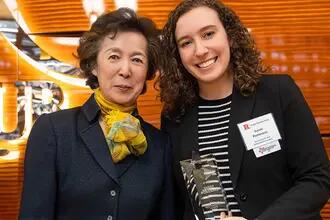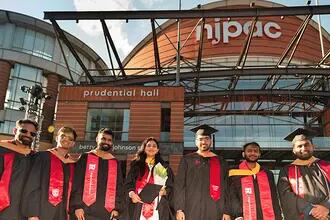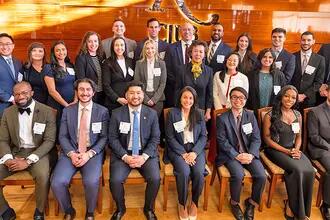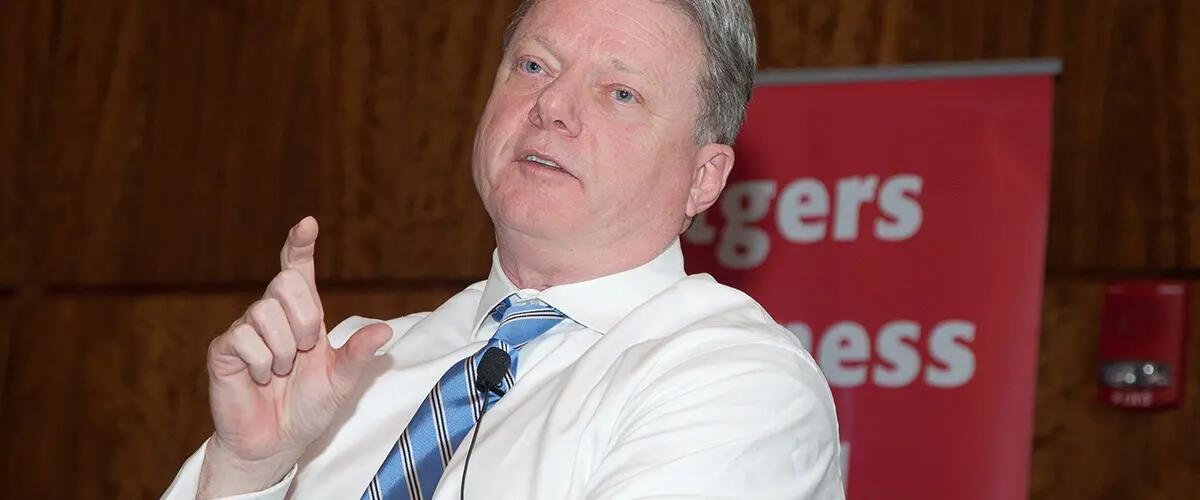
PANASONIC CEO JOSEPH TAYLOR
CEO Lecture Series offers Rutgers students a top executive's perspective on Panasonic's business turnaround
Joseph Taylor, chairman and chief executive officer of Panasonic’s North American business, is a big believer in the powerful lessons people can learn when things go wrong. The company’s turnaround success is a case in point.
Taylor provided Rutgers Business School students with a candid look at the tough decisions, the strategy and leadership that returned the company to profitability after a series of missteps led to huge losses for Panasonic beginning in 2006.
"The trend is positive now,” Taylor told the audience at the CEO Lecture Series on Feb. 20 at Rutgers Business School. “We’ve learned a lot from the mistakes we’ve made.”
Taylor’s visit was the latest segment in the CEO Lecture Series, an event that has featured 10 executives including a number of notable Rutgers MBA alums such as Avon Chief Executive Officer Sheri McCoy, Deloitte & Touche CEO Greg Weaver and PSE&G’s top boss Ralph Izzo.
"This is a great opportunity for our faculty, our staff, our alumni, but especially, for our students to get insights directly from world class leaders,” Rutgers Business School Dean Glenn Shafer said as he welcomed Taylor, who has forged connections with Rutgers in his role at Panasonic. His Feb. 20 visit drew a crowd of nearly 100 people, most of whom were Rutgers MBA students.
After his talk, Taylor fielded questions from students and faculty, and during a post-lecture reception, students had a chance to speak with Taylor one-on-one. Panasonic recently moved its North American headquarters to a brand new glass office tower in downtown Newark joining Prudential, PSEG, Horizon Blue Cross Blue Shield and Audible.com in making Newark home.
Taylor, who has spent three decades at Panasonic, gave the audience a taste of the Japanese company’s history – one of its earliest products was a bicycle lamp and it was one of the first businesses to pay men and women equally – and success before explaining how rapid shifts in consumer demand for plasma TV and the acquisition of one-time rival Sanyo left Panasonic hampered by losses. With unusual candor, Taylor recounted how executives started to see changes occurring in the marketplace, but failed to respond quickly enough.
It was a costly mistake: Over a two-year period, Panasonic’s losses exceeded $15 billion. The company’s struggles are well-chronicled. Executives had to cut costs, close factories, sell assets and identify new businesses.
Panasonic’s turnaround was helped by the steady growth of its business-to-business products and a new strategy of forging partnerships around the company’s technology in order to provide solutions to a variety of customers. For instance, Taylor said Panasonic combined its digital technology with solar panels to provide an energy solution to Sonoma Raceway. It now supplies Lithium Ion batteries to Tesla Motors, the electric car manufacturer and provides lightweight in-flight entertainment and communications systems for the airline industry, he said.
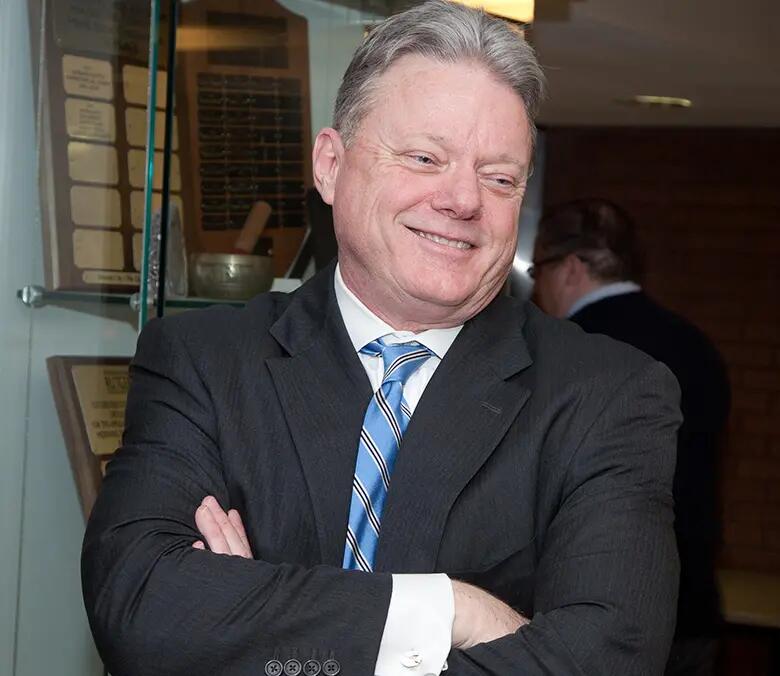
By late 2012, Panasonic’s efforts were showing signs of paying off. Revenues began increasing and so did the value of the company’s stock. When the most recent quarterly earnings were posted in early February, Wall Street analysts suggested that Panasonic’s turnaround might serve as a model for one of its rivals, which continues to struggle with ailing profits.
Taylor is confident Panasonic is on the right track. Some of the strategies that were started in the U.S. market will be adopted by the company in other markets to continue to improve the company’s performance, he said.
"This won’t happen overnight,’’ Taylor said of the turnaround. “North America is serving as a model for all of Panasonic. This isn’t a guess. We know this works.”
Before Taylor spoke to the crowd in Rutgers Business School's Bove Auditorium, he answered a few questions about management, what it takes to get to the corner office and some of his favorite places in Newark.
What were some of the biggest challenges you faced in trying to move Panasonic USA beyond its business difficulties?
"If we frame this in the theme of transformation, I think the single biggest challenge that any CEO has is change. I mean change in the very large sense. People don’t even like to change their shampoo let alone the way they do business and so the biggest difficulty I found is explaining the need and the requirement for change.”
So, how do you address that?
"Communication is the obvious answer, but communication one-on-one or one-on-many, it’s not enough. It has to be not only explaining what you’re trying to do, explaining your vision, explaining your strategy, then it’s a matter of credibility, proving to the employees that your vision is the correct vision and that these changes that you’ve identified will actually lead the company where you want it to go. So, it’s communication, action, credibility, communication, communication, communication.”
What are some of the experiences that you have drawn on as you’ve taken on higher levels of leadership?
"I don’t think this would surprise anybody, but the biggest lessons were the failures. I don’t think we learn much from successes, maybe just hubris and how wonderful we are, but I don’t think those are lessons that serve us well in life. For me personally, the failures that I’ve had have made indelible marks in my mind, but not in a bad way. The biggest lesson that I take away from it is, if you’re not making any mistakes, I’m pretty sure you’re not doing anything, so in some sense the more mistakes you’ve made, the more you’ve done. Assuming you’re not making the same mistakes over and over, it becomes a real learning experience.”
When you look around the business world, who do you view as a leader?
"I think there’s a tremendous list of leaders, but the one that pops into my head right away is Anne Mulcahy, who was the chairman and CEO of Xerox. I found her to be an amazing and astounding leader for many different reasons. One, she identified the fact that most of the problems in a corporation occur as a result of the management. Quite often, we like to blame external factors for why things didn’t happen. But she said no, it’s the management team that makes decisions, that creates the culture. Beyond that, I found her to be overwhelmingly caring for her employees and customers. I found that to be a remarkable characteristic in the stereotypical world of cold-hearted CEOs. Paul Tagliabue, who was a NFL commissioner for 17 years, also is a remarkable leader to me. If you think about what his job was, it wasn’t football. It was trying to get 32 billionaires to agree to the same thing, to go in the same direction. It’s almost impossible to conceive that one person could get them going in the same direction for the common good and yet he did. When he took over as commissioner of the NFL, the average franchise was worth about $200 million. And when he left, the average value was about $1 billion, so you would say he did a pretty good job at increasing the value of the franchises and that he took the NFL from a national sport to a global place.”
What advice would you give business students about how to be successful in the work world?
"I’d tell them what I told my kids. The first thing I told them is that power and money aren’t the only things in the world. I don’t know that those are admirable goals in and of themselves. What kind of person are you? That being said, everyone wants to do well in their jobs, so the easiest answer is to work hard, do a good job. In the workplace, the more things you volunteer for, the more your experience grows, the more your network grows and the more your value grows. I don’t think young people today should expect their company to take care of them. They should craft their own careers. They should take the time to find out what are the requirements for these higher jobs they think they want to have. Do they have the competencies for those jobs? How can they get the competencies for those jobs? Can they get it through education? Can they get it through volunteering for projects? You have to take control of your own career. Don’t be afraid to take risks, to make mistakes and to work as hard as you can.”
Panasonic opened its U.S. headquarters in Newark late last year, so do you have a favorite new spot?
"I’ll tell you about some of my favorite spots, but some of them were my favorites before we got here. NJPAC is an incredible place to see anything. It’s one of the crown jewels. I think the Newark Museum is a magnificient museum. I can’t believe more people don’t know about it and frankly, I didn’t know about it until I got here. Branch Brook Park during the cherry blossoms is as nice as (Japan’s) Yokohama City Park during cherry blossom season.”
-Susan Todd
Press: For all media inquiries see our Media Kit
